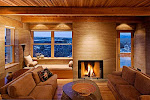Hi Kirk,
I would like to say thanks for your dedication to fine photographs. I share your appreciation of architecture. I also like the way you've managed to combine your commercial photography preference with your artistic aspirations and vision.Thanks Max. "Seeing it as one" was a long journey. I "grew up" artistically in an environment that disdained commercial photography at the renowned University of New Mexico Photography Department of the early 70's. This was during the rein of legends such as Van Deuron Coke and Beumont Newhall. Commercial photography was somehow tainted. Some years after graduation, I got into commercial architectural photography because I had a family to support and I was not accomplishing that strictly doing art photography and showing in galleries. Mentally it was not a happy marriage. I considered art my passion and the other what I did to support my passion. That doesn't mean I approached architectural photography with a lack of sincerity. Everything worth doing deserves serious attention, but commercial photography was, in my mind, definitely a second class citizen.
I suppose it's a common struggle. Your site makes it all seem like one.
I defined the distinction this way. My art was illustrating my own ideas while the commercial photography was illustrating my clients ideas, but over the years that commercial point of view didn't hold water. Clients were hiring me to see into their designs. They were asking me to interpret their art. Many of the best designers I worked for didn't even do a walk through with me-sending me out to "see what I came up with". They saw me as an artist interpreting their art (that isn't to say that there is not a documentary aspect to AP, because there definitely is. You have to show the building). Many of these same architects are aavid collectors of my b&w work too.
In 2003 New Mexico magazine approached me about doing a retrospective book of my work, which became Shelter from the Storm: The Photographs of Kirk Gittings. I suggested a collection of my B&W, but they wanted it all. It was inseparable from their POV. I could not figure out how this would work organizationally or visually. I tried many times to come up with a workable draft, but I couldn't see it and finally turned the project over to their designers. My conceptual separation of the work was a barrier, but not for them. This experience really made me re-evaluate how I see my commercial work. It is more seamless for me now as a result of that project. I learned allot from that experience. Is there really a fundamental difference where a commission comes from, whether from a commercial client, an arts program or my own internal quest? What about being invited to participate in a group exhibit with a theme? Here is an example from a show where 20 photographers were asked to photograph the same model. Model Rose Bryant photographed at the ruined 17th century church at Quarai (Canon 5D, 24 T/S).

The experience led me to (or back to really, I had played with this some years ago) an interest in photographing figures in architecture and landscape, and led to a recent arts commission to photograph figures in landscape around Albuquerque. I don't find client requirements to be barriers to creativity, but instead stimulus to creativity.


















